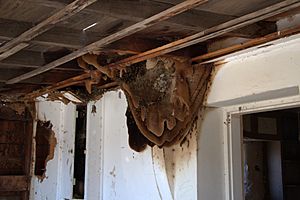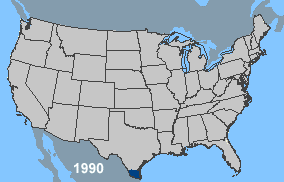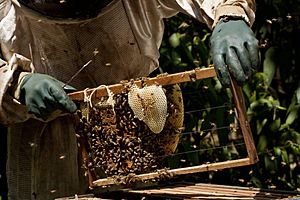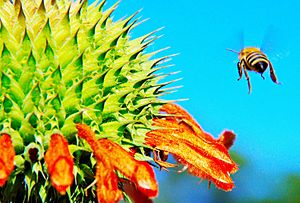Africanized honeybee facts for kids
Quick facts for kids Africanized honey bee |
|
|---|---|
 |
|
| Scientific classification | |
| Kingdom: | |
| Phylum: | |
| Class: | |
| Order: | |
| Suborder: | |
| Subfamily: |
Apinae
|
| Tribe: | |
| Genus: | |
| Species | |
|
HYBRID (see text) |
|
Africanized honeybees are a hybrid of the European honeybee and African bees. They are more dangerous and defensive than regular honeybees. Because of this, some people call them 'killer bees'. These hybrids tend to retain certain behavioral traits from their African ancestors that make them less desirable for domestic beekeeping.
They are descended from 26 Tanzanian queen bees accidentally released in 1957 in Southern Brazil from hives operated by biologist Warwick E. Kerr, who had interbred European honeybees and bees from southern Africa.
Hives containing these particular queens were noted to be especially defensive. Kerr was attempting to breed a strain of bees that would be better adapted to tropical conditions (i.e., more productive) than the European bee used in North America and southern South America.
Characteristics
Africanized bees are characterized by their aggressiveness in establishing new hives and in their vigorous defensive behavior, attacking perceived threats to their hive, including people. Over the decades, hundreds of deaths in the Americas have been attributed to Africanized bees, many deaths resulting from multiple bee stings. This defensiveness has earned them the nickname "killer bees".
- To have a tendency to frequently swarm
- To be more likely to abscond as part of a seasonal migratory pattern in response to lowered food supply
- To have greater defensiveness when in a resting swarm
- To live more often in ground cavities than the European types
- To be highly defensive in guarding the hive, with a larger alarm zone around the hive
- To have a high proportion of "soldier" bees within the hive prepared for exit and defense
- To recruit additional bees from within the hive for defense
- To pursue and sting perceived threats in far greater numbers and over much longer distances
Geographic spread
As of 2002 Africanized honeybees had spread from Brazil south to northern Argentina and north to South and Central America, México, Texas, Arizona, New Mexico, and southern California. Their expansion stopped for a time at eastern Texas, possibly due to the large number of European bee beekeepers in the area. However, discoveries of the bees in southern Louisiana indicate this species of bees has penetrated this barrier, or have come as a swarm aboard a ship. In the summer of 2005, africanized bees were discovered in six counties of Florida where they had apparently been present long enough to spread widely without detection.
How to avoid bees

- Use caution with power mowers: Bees are sensitive to low frequency vibrations and so an engine driven lawn mower may bring on a defense response from a hive or swarm
- Walk with care in clover and near picnic sites: Take care not to walk barefoot on lawns containing blooming clover, which attracts foraging bees
- Avoid perfume, cologne and scented cosmetics: Foraging bees will seek out floral scents. Such a bee will be harmless to you unless you swat at it, as it is only trying to find a flower
- Beware of head-butting bees: Honeybees usually have a small number of sentry bees patrolling the perimeter of the hive's territory. In some cases these sentry bees will head butt any animal that enters the hive's territory. If the animal continues closer to the hive, the bee will sting. If bees start head-butting you, use this behavior as a warning to retrace your steps and walk away from the hive. Choosing any other path could lead you deeper into the hive's territory
- Wear light colors: Honeybees react to dark colors. Knowing this, beekeepers always wear white or light colored protective suits when working with bees during daylight. Bees have poor night vision and so beekeepers wear dark colors when collecting swarms after sunset. When traveling through areas with bees, wear light colors to avoid attracting bees. Bees are inactive at night and are unlikely to be encountered unless you bump into a resting swarm
Related pages
Images for kids
-
Africanized honey bees gathering pollen at an Engelmann's prickly pear in the Mojave Desert
-
An African honey bee extracts nectar from a flower as pollen grains stick to its body in Tanzania (this is a purebred African honey bee, not an 'Africanized' hybrid honey bee).
See also
 In Spanish: Abeja africanizada para niños
In Spanish: Abeja africanizada para niños







